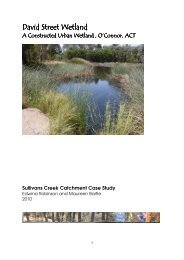4.2.2 Family Cyprinidae: Carps, Minnows etc. The Cyprinidae is one ...
4.2.2 Family Cyprinidae: Carps, Minnows etc. The Cyprinidae is one ...
4.2.2 Family Cyprinidae: Carps, Minnows etc. The Cyprinidae is one ...
Create successful ePaper yourself
Turn your PDF publications into a flip-book with our unique Google optimized e-Paper software.
4.2.3 <strong>Family</strong> Cobitidae: Loaches<br />
<strong>The</strong> Cobitidae <strong>is</strong> a large family native to Europe and Asia and are popularly kept as aquarium f<strong>is</strong>h.<br />
A single species, Oriental Weatherloach, has been widely introduced to other parts of the world including<br />
Australia. Th<strong>is</strong> species <strong>is</strong> found in the ACT and surrounding area.<br />
Common Name: Oriental Weatherloach<br />
Scientific Name: M<strong>is</strong>gurnus anguillicaudatus (Cantor 1842)<br />
Other Common Names: Japanese Weatherloach, Japanese Weatherf<strong>is</strong>h, Japanese Loach, Mud Loach,<br />
Weatherf<strong>is</strong>h, Dojo,<br />
Other Scientific Names: M<strong>is</strong>gurnus fossil<strong>is</strong> anguillicaudatus, Cobit<strong>is</strong> fossil<strong>is</strong>, Cobit<strong>is</strong> anguillicaudatus<br />
Photo: N. Armstrong<br />
Biology and Habitat<br />
Oriental Weatherloach <strong>is</strong> a bottom-dwelling f<strong>is</strong>h, native to central and eastern Asia. In the local region they<br />
grow to approximately 200 mm length. In Australia it has been imported since the 1960s and was a popular<br />
aquarium f<strong>is</strong>h. It was first detected as a breeding population in the wild in Australia in 1984, and its<br />
importation was banned in 1986. It <strong>is</strong> commonly found in slow-flowing or still water with sand or mud<br />
substrates into which it can burrow to escape predation or aestivate. Oriental Weatherloach occur in a range<br />
of habitats from degraded urban and rural streams and ponds to relatively pr<strong>is</strong>tine headwater streams. <strong>The</strong>y<br />
can util<strong>is</strong>e atmospheric oxygen by ‘gulping’ air and passing it through a highly vascular<strong>is</strong>ed hindgut. <strong>The</strong><br />
species <strong>is</strong> eurythermal and thrives in water temperatures from 2–30˚C and has been recorded in thermal<br />
springs at temperatures up to 38˚C. <strong>The</strong> species can move overland to d<strong>is</strong>perse and colon<strong>is</strong>e new water<br />
bodies. Weatherloach are multiple spawners, laying 4,000–8,000 eggs per spawning with the spawning site<br />
being aquatic vegetation or mud. Eggs are approximately 1.5 mm diameter. F<strong>is</strong>h are mature at approximately<br />
100 mm total length and may live for up to 13 years. Spawning occurs in summer with eggs hatching after<br />
2–3 days.<br />
64 F<strong>is</strong>h in the Upper Murrumbidgee Catchment: A Review of Current Knowledge





